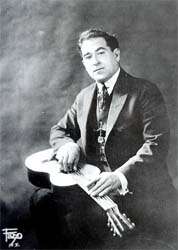Frank Ferera
Frank Ferera (June 12, 1885 - June 26, 1951) was a Hawaiian musician who recorded successfully between 1915 and 1930. He was the first star of Hawaiian music and influenced many later artists.
Frank Ferera | |
|---|---|
 Frank Ferera | |
| Background information | |
| Birth name | Frank Ferreira |
| Also known as | Frank Ferera Palakiko Ferreira |
| Born | June 12, 1885 Honolulu, Oahu, Hawaii |
| Died | June 26, 1951 (aged 66) |
| Occupation(s) | Live performer |
| Instruments | Ukulele Guitar |
| Years active | 1900 – 1951 |
| Labels | [1] |
| Associated acts | [1] List
|
Biography
Frank Ferera was born in Honolulu, Hawaii in 1885 of Portuguese ancestry.[9] Ferera first visited mainland United States as part of the Keoki E Awai troupe, which had been booked to entertain at the Panama-Pacific International Exposition.[10]
He married Helen Louise Greenus, daughter of Seattle businessman Albert E. Greenus,[11] and toured with her through the USA, appearing in vaudeville. In 1915, they signed a contract with Columbia Records and recorded prolifically.
On December 12, 1919, Frank and Helen were on board the steamship SS President, from Los Angeles back to their home in Seattle. Frank reported that Helen had gone on deck for a walk at 4 a.m. and never returned. After a search failed to turn up the missing Mrs. Ferera, she was presumed lost at sea.[11]
In 1924, Frank played guitar accompaniment to Vernon Dalhart's ballad "Wreck of the Old 97" (Victor Record No. 19427), sometimes cited as the first million-selling country music release in the American record industry.[12]
In the late 1920s, during a wave of Hawaiian music popularity, Frank Ferera's Hawaiian Trio recorded a number of songs with jazz singer Annette Hanshaw, including: "Was It A Dream?", "For Old Time's Sake", "Get Out and Get Under the Moon", "I Love A Ukulele", "Lonely Nights In Hawaii", "Chiquita", "Maui Girl", "Sonny Boy", "Sweet Lei Lehua", "Carolina Moon", "Maui Chimes", "Pagan Love Song", "Singing in the Rain", "Ua No a Like - Sweet Constancy", and "Forget Me Not", "Lazy Louisiana Moon", and "Pale Blue Waters".
While Ferera was the first commercially successful Hawaiian recording artist in the teens, by the late 1920s, a new wave of steel guitarists, including Sol Hoʻopiʻi, were upstaging him.
Ferera married three times. He died on June 26, 1951, due to complications following a stroke. He was survived by his third wife, Ruth, son Frank Ferreira III and daughter Mary Ferreira.[13]
Singles

- My Old Kentucky Home
- Kilima Waltz
- Along The Way To Waikiki
- Maui Chime
- Southern Blues
- Dreamin'
References
- Gracyk, Tim; Hoffman, Frank; Cooper, B Lee (2000). Popular American Recording Pioneers: 1895-1925. Routledge. pp. 118–127. ISBN 978-0-7890-1220-3.
- "Anthony J. Franchini". UCSB Libraries. Retrieved 23 May 2010.
- "Athenian Mandolin Quartet". UCSB Libraries. Retrieved 23 May 2010. Regents of the University of California
- "Dave Kaili". UCSB Libraries. Retrieved 23 May 2010. Regents of the University of California
- "The Hawaiian Trio". UCSB Libraries. Retrieved 23 May 2010. Regents of the University of California
- "Irene Greenus". UCSB Libraries. Retrieved 23 May 2010. Regents of the University of California
- "John K. Paaluhi". UCSB Libraries. Retrieved 23 May 2010. Regents of the University of California
- "Vernon Dalhart". UCSB Libraries. Retrieved 23 May 2010. Regents of the University of California
- Gronow, Pakka; Saunio, Ilpo (1999). International History of the Recording Industry. Continuum. p. 32. ISBN 978-0-304-70590-0.
- Tosches, Nick (1996). Country: The Twisted Roots Of Rock 'n' Roll. Da Capo Press. p. 174. ISBN 978-0-306-80713-8.
- Blecha, Peter. "Seattle's star Hawaiian guitarist, Helen Louise Ferera, mysteriously disappears from a steamship on December 12, 1919". Washington State History. Retrieved 9 October 2010.
- "Tim Gracyk's Phonographs, Singers, and Old Records -- Vernon Dalhart". gracyk.com. Retrieved 1 November 2016.
- Popular American recording pioneers, 1895-1925 By Tim Gracyk, Frank W. Hoffmann
External links
- Works by Frank Ferera and John Paaluhi at Project Gutenberg
- Works by or about Frank Ferera at Internet Archive
- Frank Ferera, Guitarist, Victor Library
- Frank Ferera, Ukulele, Victor Library
- Frank Ferera, Composer, Victor Library
- Frank Ferera, Steel Guitarist, Victor Library
- Louise and Ferera, Victor Library